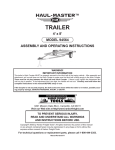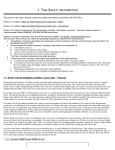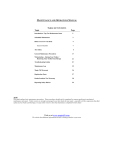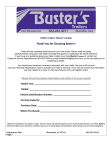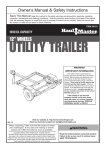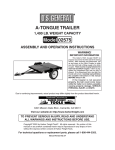Download Harbor Freight Tools 870 lb. Capacity 40 in. x 49 in. Utility Trailer Product manual
Transcript
Owner’s Manual & Safety Instructions Save This Manual Keep this manual for the safety warnings and precautions, assembly, operating, inspection, maintenance and cleaning procedures. Write the product’s serial number in the back of the manual near the assembly diagram (or month and year of purchase if product has no number). Keep this manual and the receipt in a safe and dry place for future reference. ITEM 42708 WARNING! IMPORTANT INFORMATION SPECIFICATIONS Max. Payload Capacity GVWR Net Weight Rim Size Tire Size Tire Pressure Hitch Ball Bed Frame Overall Length 870 lb. 1,000 lb. 125 lb. 8 x 3.75 w/4 Lug Nut Pattern 4.8 - 8 (B), 4 PR 60 PSI, cold 1-7/8″, Class I 40" x 48" 81-1/2" This trailer’s Hitch Coupler MUST be properly secured to the hitch ball of the towing vehicle. After assembly and attachment, pull up and down on the Hitch Coupler to make sure the hitch ball is fitting snugly in the Hitch Coupler. There must be no play between the hitch ball and the Hitch Coupler. If there is play, tighten the Adjustment Nut until no play is present. If the Adjustment Nut is too tight, the Handle will not lock. Carefully read and follow the complete instructions in this manual BEFORE setup or use. If the coupler is not secured properly, the ball could come loose while the trailer is in motion, possibly causing property damage, SERIOUS PERSONAL INJURY, or DEATH. Visit our website at: http://www.harborfreight.com Email our technical support at: [email protected] REV 14i When unpacking, make sure that the product is intact and undamaged. If any parts are missing or broken, please call 1-888-866-5797 as soon as possible. Copyright© 2012 by Harbor Freight Tools®. All rights reserved. No portion of this manual or any artwork contained herein may be reproduced in any shape or form without the express written consent of Harbor Freight Tools. Diagrams within this manual may not be drawn proportionally. Due to continuing improvements, actual product may differ slightly from the product described herein. Tools required for assembly and service may not be included. Read this material before using this product. Failure to do so can result in serious injury. SAVE THIS MANUAL. Page 2 For technical questions, please call 1-888-866-5797. Item 42708 Item 42708 For technical questions, please call 1-888-866-5797. Page 3 Tongue and Groove Pliers Drill (for installing plywood base) Page 4 For technical questions, please call 1-888-866-5797. Item 42708 DON’T TIGHTEN YET! TO MAKE ASSEMBLY EASIER, wait until assembly is complete and all hardware is in place before tightening any nut or bolt. Leave hardware snug until then. Item 42708 For technical questions, please call 1-888-866-5797. Page 5 DON’T TIGHTEN YET! TO MAKE ASSEMBLY EASIER, wait until assembly is complete and all hardware is in place before tightening any nut or bolt. Leave hardware snug until then. Page 6 For technical questions, please call 1-888-866-5797. Item 42708 DON’T TIGHTEN YET! TO MAKE ASSEMBLY EASIER, wait until assembly is complete and all hardware is in place before tightening any nut or bolt. Leave hardware snug until then. Item 42708 For technical questions, please call 1-888-866-5797. Page 7 DON’T TIGHTEN YET! TO MAKE ASSEMBLY EASIER, wait until assembly is complete and all hardware is in place before tightening any nut or bolt. Leave hardware snug until then. Page 8 For technical questions, please call 1-888-866-5797. Item 42708 TIGHTEN ALL HARDWARE! Now that frame is completely assembled, retrace all assembly steps and make sure that all hardware is properly wrench‑tightened. Also, tighten lug nuts/lug bolts to 90 ft-lb. Item 42708 For technical questions, please call 1-888-866-5797. Page 9 Page 10 For technical questions, please call 1-888-866-5797. Item 42708 Item 42708 For technical questions, please call 1-888-866-5797. Page 11 Page 12 For technical questions, please call 1-888-866-5797. Item 42708 • Maximum tire width means- the greater of either the linear distance between the exterior edges of the carcass or the linear distance between the exterior edges of the tread, both being measured parallel to the rolling axis of the tire. TIRE INFORMATION Tire Terminology Glossary • Accessory weight means- the combined weight of automatic transmission, power steering, power brakes, power windows, power seats, radio, and heater, to the extent that these items are available as factory-installed equipment. • Carcass means- the tire structure except for the tread which provides the major portion of the tire’s capability to deflect in response to the vertical loads and tractive forces that the tire transmits from the roadway to the non-pneumatic rim, the wheel center member, or the vehicle and which attaches to the vehicle or attaches, either integrally or separably, to the wheel center member or non-pneumatic rim. • Carcass separation means- the pulling away of the carcass from the non-pneumatic rim or wheel center member. • Chunking means- the breaking away of pieces of the carcass or tread. • Normal occupant weight means- 68 kilograms times the number of occupants. • Occupant distribution means- distribution of occupants in a vehicle. • Production options weight means- the combined weight of those installed regular production options weighing over 2.3 kilograms in excess of those standard items which they replace, not previously considered in curb weight or accessory weight, including heavy duty brakes, ride levelers, roof rack, heavy duty battery, and special trim. • Tread means- that portion of the tire that comes in contact with the road. • Tread separation means- pulling away of the tread from the carcass. • Vehicle capacity weight means- the rated cargo and luggage load plus 68 kilograms times the vehicle’s designated seating capacity. • Cracking means- any parting within the carcass, tread, or any components that connect the tire to the wheel center member. • Curb weight means- the weight of a motor vehicle with standard equipment including the maximum capacity of fuel, oil, and coolant, and, if so equipped, air conditioning and additional weight optional engine. • Load rating means- the maximum load a tire is rated to carry. • Maximum loaded vehicle weight means- the sum of: a.Curb weight; b.Accessory weight; c.Vehicle capacity weight; and d.Production options weight. • Vehicle maximum load on the tire means- that load on an individual tire that is determined by distributing to each axle its share of the maximum loaded vehicle weight and dividing by two. • Vehicle normal load on the tire means- that load on an individual tire that is determined by distributing to each axle its share of the curb weight, accessory weight, and normal occupant weight and dividing by 2. Tire Markings Inner diameter in inches Section width in inches Load index and Speed rating* European tire certificate* U.S. DOT tire identification number Tire ply composition and materials used Maximum permissible inflation pressure Maximum load rating Trailer tire Item 42708 *Information not required by U.S. DOT For technical questions, please call 1-888-866-5797. Page 13 • Section width- This number gives the width of the tire in inches. The larger the number, the wider the tire. (The markings on the example tire diagram show 4.80. The markings on your tire may differ.) • Inner diameter- This number gives the inner diameter of the tire in inches. This is also the rim diameter in inches. (The markings on the example tire diagram show 12. The markings on your tire may differ.) • U.S. DOT tire identification number- This begins with the letters “DOT” and indicates that the tire meets all federal standards. The next two numbers or letters are the plant code where it was manufactured, and the last four numbers represent the week and year that the tire was built. For example, the numbers 2107 mean the 21st week of 2007. Any other numbers used are marketing codes used at the manufacturer’s discretion. This information is used to contact consumers if a tire defect requires a recall. • Maximum Load Rating- This number indicates the maximum load in kilograms and pounds that can be carried by the tire. Load Index Rating Codes Code Pounds 71 72 73 74 75 76 77 78 79 80 81 82 83 84 761 783 805 827 853 882 908 937 963 992 1,019 1,047 1,074 1,102 Code Pounds 85 86 87 88 89 90 91 92 93 94 95 96 97 98 1,135 1,168 1,201 1,235 1,279 1,323 1,356 1,389 1,433 1,477 1,521 1,565 1,609 1,653 Code Pounds 99 100 101 102 103 104 105 106 107 108 109 110 1,709 1,764 1,819 1,874 1,929 1,984 2,039 2,094 2,149 2,205 2,271 2,337 • Load index- This is a measurement of how much weight each tire can support. See chart above. (The markings on the example tire diagram show 71. The markings on your tire may differ.) Note: You may not find this information on all tires because it is not required by law. Tire Speed Rating Codes Code MPH F G J K L M 50 56 62 68 75 81 Code MPH N P Q R S T 87 94 100 106 112 118 Code MPH U H V Z W Y 124 130 149 149 168 186 • Speed Rating- The speed rating denotes the speed at which a tire is designed to be driven for extended periods of time. This does not indicate that the vehicle or rims can safely reach or maintain that speed. These ratings are listed to the right. (The markings on the example tire diagram show M. The markings on your tire may differ.) Note: You may not find this information on all tires because it is not required by law. • Tire Ply Composition and Materials Used- The number of plies indicates the number of layers of rubbercoated fabric in the tire. In general, the greater the number of plies, the more weight a tire can support. Tire manufacturers also must indicate the materials in the tire, which include steel, nylon, polyester, and others. • Maximum Permissible Inflation Pressure- This number is the greatest amount of air pressure that should ever be put in the tire under normal driving conditions. BEARING PACKING INSTRUCTIONS Important Read and adhere to the following instructions; failure to read and obey all of the following instructions COMPLETELY will void the warranty and can result in damage to the trailer, property damage, or SERIOUS PERSONAL INJURY. Whenever a hub is disassembled (if a hub on a new unit requires assembly or a hub is disassembled for maintenance), the following procedure MUST be followed. 1. Using a suitable solvent, thoroughly clean the bearings and the rest of the parts in the Hub assembly of all grease, dirt, metal shavings, or any other foreign object. The parts must be cleaned even if they are new or clean. 2. Allow all pieces to dry completely. 3. Make sure that your hands are thoroughly clean and the bearing packer (not included) is also thoroughly clean. Page 14 4. Place fresh, clean bearing grease in the packer. 5. With the grease-filled bearing packer in one hand and the bearing in the other, press the bearing into the grease, forcing the grease inside the slots in the bearing, continue doing this until every slot in the bearing is completely full of grease. 6. Finish assembling the hub/wheel assembly as explained in the manual, being careful not to get any dirt or debris on any part of the assembly. For technical questions, please call 1-888-866-5797. Item 42708 Tire Inflation and Load Limit The weight of cargo should never exceed 394 kg or 870 lb. TIRE SIZE COLD TIRE PRESSURE FRONT 4.80/4.00-8 410 kPa, 60 PSI REAR NONE NONE SPARE NONE NONE SEE OWNER’S MANUAL FOR ADDITIONAL INFORMATION. 12a TIRE AND LOADING INFORMATION MODEL 42708 Tire and Loading Information Placard The Tire and Loading Information Placard displays the cold tire inflation pressure and the load limit for this vehicle. See the Tire Care section for an explanation of tire pressure and see the Vehicle Load Limit section following that for an explanation of load limit. TIRE CARE Checking Tire Pressure Note: Underinflated tires can decrease handling, stopping performance, traction, tire life, and load-carrying capability, in addition to causing other negative and hazardous effects, including tire failure. Overinflated tires are at greater risk of an impact break, where the tread and casing break when striking a hard edge, often opening a huge gash across the tread. Incorrect inflation pressure also increases tires wear rate. Therefore, it is important to keep tires inflated properly. Steps for Maintaining Proper Tire Pressure 1. Locate the recommended tire pressure on the vehicle’s tire information placard, certification label, or in the owner’s manual. This trailer has 60 PSI recommended cold tire inflation pressure. 2. Measure and record the tire pressure of all tires. 3. If the tire pressure is too high in any of the tires and the tires have not been driven for at least three hours, slowly release air by gently pressing on the tire valve stem with the edge of your tire gauge until you get to the correct pressure. If the vehicle have been driven within the past three hours and the tire pressure is too high on any tires, then recheck the pressure once the tires have been allowed to sit motionless for at least three hours. 4. If the tire pressure is too low, note the difference between the measured tire pressure and the correct tire pressure. These “missing” pounds of pressure are what you will need to add. 5. At a service station, add the missing pounds of air pressure to each tire that is underinflated. 6. Check all the tires to make sure they have the same air pressure. 7. If the tires’ pressure was not measured “cold”, then the pressure should be rechecked with the tires cold as soon as possible. Check all tires’ pressure at least monthly, due to the following factors: • Most tires naturally lose air gradually. • Tires can suddenly lose air if the tire strikes a pothole, curb, or other object. • It is usually not possible to determine underinflation of radial tires by visual inspection. This vehicle has 60 PSI recommended cold tire inflation pressure. The term “cold” in this manual does not refer to the temperature outside, but it refers to the fact that a tire that has not been driven for a period is cooler (and therefore has lower pressure) than a tire that has been driven on. Tires heat up while being driven on. To check (or fill to) a tire’s cold inflation, the tire must have not been driven for more than a mile or two for at least three hours. If you check a tires pressure when it is not “cold”, the pressure will appear higher than the actual cold tire inflation. Item 42708 For technical questions, please call 1-888-866-5797. Page 15 Tire Size Tire Balance and Alignment To maintain safety, only purchase new tires of the same size as the original tires. Look at the Tire and Loading Information Placard, the Specifications Chart in this manual, or the sidewall of the tire being replaced. If you have any doubt about selecting the correct size, consult a tire dealer. The tires need to be balanced to prevent vibration when driving. This involves attaching small weights to the rim to offset small differences in rim and tire weight. The tires also need to be aligned properly. Alignment is the orientation of the tires to the road surface and their being parallel. This helps the tires to wear evenly, and provide better traction. Both tire balance and alignment require specialized equipment that is not provided with this vehicle. Tire Tread The tire tread provides traction that prevents your vehicle from slipping, especially if the road is wet or icy. Tires are unsafe and should be replaced when the tread is worn down to 1/16”. Measure tread depth using a tread depth indicator (not included). Tire Rotation Every 5,000 miles the left and right tires should be switched. This will cause the tires to wear more evenly and last longer. Page 16 Tire Repair To properly repair a punctured tire, the hole needs to be properly plugged and patched from the inside of the tire. Tread punctures can be repaired if they are not too large. Sidewall punctures should not be repaired, the tire needs to be replaced if the sidewall is damaged. Tires should be removed from the rim to be inspected before being plugged and patched. A qualified mechanic should remove the tire from the rim, perform the repair, and remount the tire. For technical questions, please call 1-888-866-5797. Item 42708 VEHICLE LOAD LIMIT Steps for Determining Correct Load Limit 1. Locate the statement “The weight of cargo should never exceed XXX kilograms or XXX pounds” on your vehicle’s placard. 2. That figure equals the available amount of cargo and luggage load capacity. 3. Determine the combined weight of luggage and cargo being loaded on the vehicle. That weight may not safely exceed the available cargo and luggage load capacity. 4. If the trailer’s load exceeds the cargo and luggage load capacity, then the trailer be unsafe resulting in hazardous effects, such as: Trailer’s tires will not be able to maintain traction properly, and stopping distance will be increased significantly. Item 42708 For technical questions, please call 1-888-866-5797. Page 17 IMPORTANT For safe use and operation, obey the following notices: 1. Read all instructions carefully and follow them step-by-step. Keep the instruction manual in a safe place. 2. Double-check the assembly after you finish to ensure everything is assembled properly. 3. Follow the Trailer Licensing notice to properly license this trailer. 4. Inspect before every use; do not use if parts are loose or damaged. 5. Keep permanent labels in place and in good condition. Notice: • Repack bearings after every 3,000 miles of use. • Maintain tires as explained in this manual. • Comply with the following before every use: 6. Tighten U-bolt. 7. Tighten lug nut. 8. Tighten trigger lock on coupler. 9. Hook up safety chain. 10. Trailer load should not exceed 870 lb. capacity and must be properly secured. 11. Trailer load size must not exceed trailer’s bed board size. CORRECT WAY TO LOAD THE TRAILER YES Page 18 NO O X O X O X O X For technical questions, please call 1-888-866-5797. Item 42708 Limited 90 Day Warranty Harbor Freight Tools Co. makes every effort to assure that its products meet high quality and durability standards, and warrants to the original purchaser that this product is free from defects in materials and workmanship for the period of 90 days from the date of purchase. This warranty does not apply to damage due directly or indirectly, to misuse, abuse, negligence or accidents, repairs or alterations outside our facilities, criminal activity, improper installation, normal wear and tear, or to lack of maintenance. We shall in no event be liable for death, injuries to persons or property, or for incidental, contingent, special or consequential damages arising from the use of our product. Some states do not allow the exclusion or limitation of incidental or consequential damages, so the above limitation of exclusion may not apply to you. THIS WARRANTY IS EXPRESSLY IN LIEU OF ALL OTHER WARRANTIES, EXPRESS OR IMPLIED, INCLUDING THE WARRANTIES OF MERCHANTABILITY AND FITNESS. To take advantage of this warranty, the product or part must be returned to us with transportation charges prepaid. Proof of purchase date and an explanation of the complaint must accompany the merchandise. If our inspection verifies the defect, we will either repair or replace the product at our election or we may elect to refund the purchase price if we cannot readily and quickly provide you with a replacement. We will return repaired products at our expense, but if we determine there is no defect, or that the defect resulted from causes not within the scope of our warranty, then you must bear the cost of returning the product. This warranty gives you specific legal rights and you may also have other rights which vary from state to state. Item 42708 For technical questions, please call 1-888-866-5797. Page 19 3491 Mission Oaks Blvd. • PO Box 6009 • Camarillo, CA 93011 • 1-888-866-5797




















